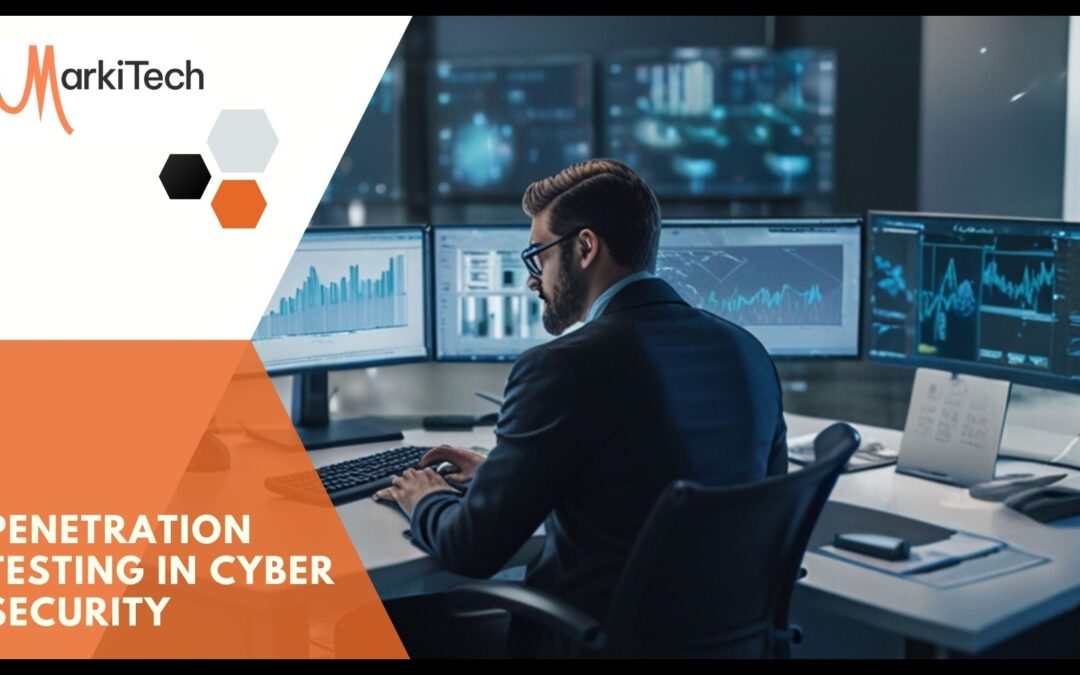Table of Contents
ToggleMedically Reviewed: Dr Hanif Chatur
Image Credit: Canva
A Comprehensive Guide
In this digitized world, cybersecurity has become more critical than ever since business now hugely relies on digital operations. It is here that penetration testing in cyber security becomes a vital process to protect sensitive information from the invading hordes. For any business, understanding the importance and execution of penetration testing is quite essential. This article explores what penetration testing is, why it matters, how it is conducted, and its relevance to businesses with a special focus on how it goes together with MarkiTech in offering security solutions.
What is Penetration Testing in Cyber Security?
It is also known as pen testing. In this new way of looking at things, it is explained as the attempts by authorized intruders, or ‘hackers’, to break into a computer system, network or networked application in order to reveal the defense vulnerabilities otherwise unavailable to an enemy. It makes it easy for organizations to be proactive in areas where weak points are more likely to be exploited through similar tactics, techniques, and procedures used by the actual threat actors.
Penetration testing not only identifies the existing security vulnerabilities but checks the efficacy of existing security mechanisms in case of an actual attack. In light of this, it has now become necessary to conduct penetration tests on organizations that store or utilize sensitive client details, business secrets or fundamental business operations over the web.
Why is Penetration Testing Important?
- The significance of Cyber Security: Cyber Security Penetration Testing is in the Evaluation of the Existing Security Systems. In this stage, existing systems, applications, and networks are assessed for already known security weaknesses in order to identify those that the business can rectify before they develop into more significant issues.
- Security Upgrades: Penetration testing goes on continuously and does not let hackers execute a breakthrough in case of new threats. Every business needs to evolve the defense measures against ever-changing cyber threats.
- Compliance and Regulations: Most industries have regulations that will always require penetration testing in cyber security so that user data would be kept safe. Non-compliance could lead to huge fines and loss of reputation.
- Building Customer Trust: Building Penetration Testing in conjunction with other elements of a robust cybersecurity framework ensures that the company means business in safeguarding customers’ information. In competitive markets, this provides a deciding edge in building trust with clients and partners.
How is Penetration Testing in Cyber Security Conducted?
The process of penetration testing in cyber security typically follows a few standard steps:
- Planning and Reconnaissance: This is about getting information from the target system. A tester will be inquisitive as to how the target works and what kind of vulnerabilities is present. This is the foundation for a good test.
- Scanning: This is scanning where automated tools identify open ports, services, and software versions on the target systems. This gives the testers an overview of how the target would react to different attempts at intrusion.
- Gaining Access: The vulnerabilities identified are attempted to be exploited in order to gain access to the target system. This phase is also a very important one in understanding the depth of damage that might be caused because it simulates the action of a real attacker.
- Access Maintained: In this area, it seeks to determine how long the hacker can retain the access to the system without being detected. It aids in evaluating the extent of damage an attacker can cause with time.
- Analysis and Reporting: This test can be used to come up with a comprehensive report that can bring out the vulnerabilities found, ways of application for exploitation of the system, and even suggestions made towards improvement of the security of the system.
- Remediation: The final phase in which practical security improvement based upon the findings will be implemented. It may involve patching specific software applications, firewall configurations, or enhancing processes of authenticating users.
Types of Penetration Testing in Cyber Security
- Network Penetration Testing: Network penetration testing aims to reveal weaknesses of the network infrastructure- routers, firewalls, and switches.
- Web Application: That is, testing specifically web applications in an effort to discover vulnerabilities such as those involved in SQL injection, cross-site scripting (XSS), broken authentication and many other similar issues.
- Social Engineering Penetration Test: This kind of test is targeted at the human element of cybersecurity and involves mimicking phishing attacks or any other kind of social manipulation to test whether any employee would fall into such traps and give away that critical information.
- Wireless Penetration Testing: Testing wireless networks against its weaknesses, due either to weak encryption standards or unauthorized access points.
Benefits of Penetration Testing for Businesses
- Cost Benefits: Identifying and remedying vulnerabilities usually through penetration testing of cyber security might be cheaper than fighting the consequences of a cyberattack.
- Operational Efficiency: A secure system means less disturbances that occur as a result of cyber attacks, which hence encourages businesses to focus more on their core activities.
- Competitive Advantage: Penetration testing can help businesses lead the industry in penetration testing where data privacy issues have played a major role thus acquiring competitive advantage while showing a business’s commitment to robust cybersecurity practices.
How MarkiTech Supports Penetration Testing in Cyber Security
At MarkiTech, we aim to utilize the most recent advancements in AI and technologies to mitigate the greatest problems within various sectors including cyber security. Thanks to our knowledge of custom software development and integration, we can help companies create a safe space within a digital landscape. Due to our innovative approach and solutions, we are able to include advanced penetration testing techniques so that the systems of our clients are secure.
We recognize the fact that cybersecurity penetration testing is often difficult and challenging especially for corporations without IT teams. This is why MarkiTech provides such consulting services to firms, making the process easier and making sure that the businesses comprehend the results and are proactive about enhancing their security within the appropriate timeframe.
Best Practices for Penetration Testing
- Regular penetration testing: Another important aspect is the performance of regular penetration testing to ensure that your system becomes more secure over time, as cyber threats keep on changing rapidly.
- Qualified Experts: Cyber security penetration testing demands expertise from knowledgeable experts. With qualified experts, penetration testing provides an assured thoroughness and accuracy.
- Integrate Testing with Development: Companies developing their internal software can catch vulnerabilities through integrating penetration testing within the development cycle before the software is deployed.
- Pay Specific Attention to High-Risk Areas: Test areas of the application that hold sensitive customer data or are exposed to the internet as the first priority.
Conclusion
In light of the increasing cyber threats, it is inevitable that businesses should prioritize their security measures. This process and safeguard against weaknesses in systems in even more depth is where cyber security penetration tests find their relevance. MarkiTech is one such organization, which can help its clients establish the right penetration testing practices and more importantly, help in ensuring the practice is done in the best way possible.
Also, incorporating penetration testing as part of your overall cybersecurity strategy increases your defenses, safeguards sensitive data and enhances your consumer’s confidence. It is not upon the business to protect itself from intrusion; they should also ensure that intrusions cannot compromise their business. That is, security is not just about defending against attacks but ensuring the continuity of operations is sustained over time and even in the face of adversities within and outside the digital platform.






Recent Comments